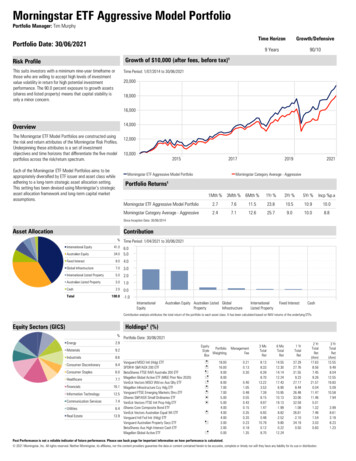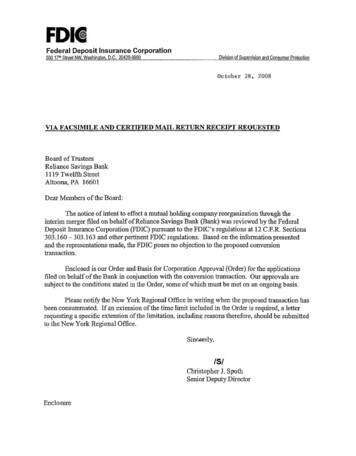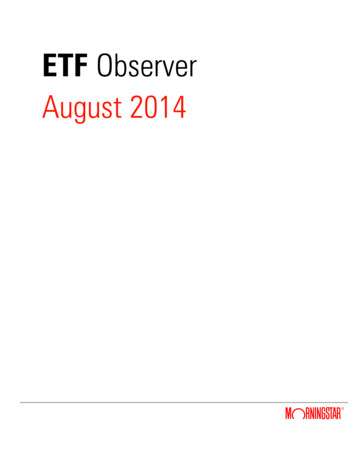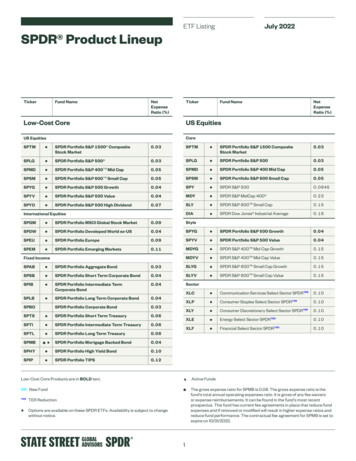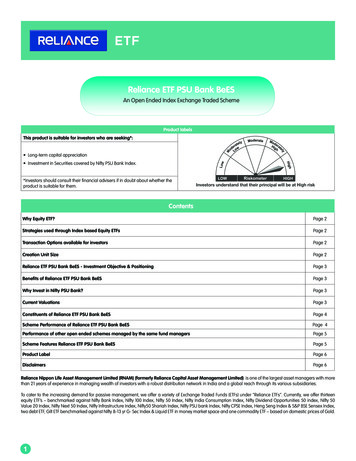
Transcription
Reliance ETF PSU Bank BeESAn Open Ended Index Exchange Traded SchemeProduct labelsThis product is suitable for investors who are seeking*: Long-term capital appreciation Investment in Securities covered by Nifty PSU Bank Index.*Investors should consult their financial advisers if in doubt about whether theproduct is suitable for them.Investors understand that their principal will be at High riskContentsWhy Equity ETF?Page 2Strategies used through Index based Equity ETFsPage 2Transaction Options available for investorsPage 2Creation Unit SizePage 2Reliance ETF PSU Bank BeES - Investment Objective & PositioningPage 3Benefits of Reliance ETF PSU Bank BeESPage 3Why Invest in Nifty PSU Bank?Page 3Current ValuationsPage 3Constituents of Reliance ETF PSU Bank BeESPage 4Scheme Performance of Reliance ETF PSU Bank BeESPage 4Performance of other open ended schemes managed by the same fund managersPage 5Scheme Features Reliance ETF PSU Bank BeESPage 5Product LabelPage 6DisclaimersPage 6Reliance Nippon Life Asset Management Limited (RNAM) (formerly Reliance Capital Asset Management Limited) is one of the largest asset managers with morethan 21 years of experience in managing wealth of investors with a robust distribution network in India and a global reach through its various subsidiaries.To cater to the increasing demand for passive management, we offer a variety of Exchange Traded Funds (ETFs) under “Reliance ETFs”. Currently, we offer thirteenequity ETF’s – benchmarked against Nifty Bank Index, Nifty 100 Index, Nifty 50 Index, Nifty India Consumption Index, Nifty Dividend Opportunities 50 index, Nifty 50Value 20 Index, Nifty Next 50 Index, Nifty Infrastructure Index, Nifty50 Shariah Index, Nifty PSU bank Index, Nifty CPSE Index, Heng Seng Index & S&P BSE Sensex Index,two debt ETF, Gilt ETF benchmarked against Nifty 8-13 yr G- Sec Index & Liquid ETF in money market space and one commodity ETF – based on domestic prices of Gold.1
Why Equity ETF? Ease of transaction - Can be easily bought / sold like any other stock on the exchange through terminals spread across the country Ease of Liquidity - Can be bought / sold anytime during market hours (subject to availability of buyer/seller) at prices prevailing in the market. Thus, investortransacts at real-time prices. Low Cost - Generally less expensive than investing in multiple individual securities or a mutual fund Other Special Features Instant diversification through exposure to a large number of stocks by purchasing as low as 1 unit Buying / selling at close to live price and not end-of-day, also ability to put limit orders Authorised Participants / Large investors can buy in creation unit size directly from the AMC at Live Prices in creation unit sizesStrategies used through Index based Equity ETFs Liquidity Management - ETFs can be used for a given percentage of each asset class to provide a liquidity buffer across the asset allocation Portfolio Completion - ETFs allow investors to gain exposure to an asset class that is under-represented in the asset allocation Cash Equitization – ETFs assist in remaining fully invested into equity as per the allocation model, while maintaining liquidity, thus minimizing the cash drageffect on the portfolio Portfolio Transitions – Since ETFs are passive funds, they may help maintain market exposure while there are changes in sector/stock allocations in a portfolio,hence avoids the risk of missing any market movementTransaction Options available for investorsSubscriptionProcessThrough Stock ExchangeFeaturesonline terminal / stock broker Can trade as less as 1 UnitFunding to be done on T 1Unit credit on T 2Transaction on Exchange traded priceNo paperworkTransaction on order matching and availabilityof quotesCan transact in multiples of creation unit sizeCan happen in Cash or basket of stocksTransaction in exchange of Portfolio deposit &Cash ComponentThrough AMC (Authorized Participants & LargeInvestors)Transaction form with requisite documents RedemptionProcessFeaturesThrough Stock Exchangeonline terminal / stock brokerThrough AMC (Authorized Participants & LargeInvestors)Redemption Request Can trade as less as 1 UnitUnits taken on T 1Amount credited T 2 Can trade in multiples of creation unit sizeCan happen in Cash or basket of stocksTransaction in exchange of Portfolio deposit &Cash ComponentLive Prices (NAV) with the basket is available on Bloomberg page “RITE” for referenceCreation Unit SizeCreation Unit size is the minimum denomination of unit that can be directly purchased/redeemed from AMCTradable UnitCompositionCreation Unit SizeNAV Value 31st May, 2018Approx. Basket Value (Rs.)1 Unit Reliance ETF PSUBank BeES 1/10 of Nifty PSU BankIndex5000 units of Reliance ETF PSUBank BeES329.61811648090.50* NAV as of 31st May, 2018 taken as reference valueImportance of Creation Unit Size In case of non-availability of sizeable quote, Investors can transact with the AMC in creation unit lotsInvestors can transact both in form of cash or stock basket comprising the indexUnits are created at live NAV price plus expenses2
Reliance ETF PSU Bank BeESInvestment Objective: Reliance ETF PSU Bank BeESThe investment objective of Reliance ETF PSU Bank BeES is to provide returns that, before expenses, closely correspond to the total returns of the Securities as represented by the Nifty PSU Bank Index. There can be no assurance or guarantee that the investment objective of the Scheme will be achieved.Positioning – Reliance ETF PSU Bank BeES Reliance ETF PSU Bank BeES is an Exchange Traded Fund (ETF) listed on NSE and invests in stocks of Nifty PSU Bank Index in the same proportion as the underlying IndexReliance ETF PSU Bank BeES is less expensive than investing in individual securities of the Nifty PSU Bank Index.It provides an opportunity to investors for passively investing in a well-expanded portfolio of top PSU banks as per free float market capitalization, as approximately represented by Nifty PSU Bank Index Benefits of Reliance ETF PSU Bank BeES Well Defined Portfolio: Reliance ETF PSU Bank BeES investment strategy & stock selection is clearly defined; it would replicate the Nifty PSU Bank Index & investonly in companies forming the index in the same proportion as the underlying index Diversification: Buying a single unit currently offers diversification of top stocks in the PSU banking sector Transparency: Nifty PSU Bank Index constituents are made available in public domain on a daily basis by NSE Liquidity: ETF units are traded on exchanges & can be easily liquidated during trading hours (subject to availabiiity of buyer/Seller). Authorised Participants /Large Investors also have the option of coming to the AMC for procurement/sale of units in creation unit sizes (5000 units with 1 unit equivalent to 1/10 of NiftyPSU Bank Index) Margin for trading on NSE : Reliance ETF PSU Bank BeES is accepted as margin for trading on NSE with applicable haircut Sector Exposure with less Idiosyncratic risk: Reliance ETF PSU Bank BeES allows one to take exposure to the banking sector with relatively less stock specificrisk, as risk gets diversified among basket of stocks Index track Record: Launched in Jan-2004, base date 1-Jan-2004 the index has a track record of 13 yearsWhy Invest in Nifty PSU Bank?Over the last couple of years, we have witnessed a steady improvement across key macroeconomic parameters like the Twin Deficits, Inflation, Currency, GDP growthetc. This along with policy reforms like GST, FDI in key areas and nonlinear positives like lower commodity prices is likely to fuel a strong economic revival over the nextfew years.Banking sector is backbone for any economy and is the key beneficiary as well as catalyst of economic recovery. We believe, the sector is set to benefit significantlyfrom the domestic recovery over the medium to long term. The sector revival is usually characterized by the key phases of lowering of interest rates, asset qualityimprovement followed by higher credit off-take. The sector offers a good play on consumption & capex revival and can be a significant beneficiary of the domesticrevival.Nifty PSU Bank Index forms the representation of Indian Banking Sector currently having 11 stocks comprising PSU banks qualifying as per the index selection criterion.With a lot of thrust being initiated from the new government on development, this sector becomes attractive for investors.*Sources: Bloomberg, BofAML Global Research estimates, World Bank, Government of India, Ministry of Industry, IMF, RMF Internal ResearchCurrent ValuationsThe P/E , P/B and dividend yield of Nifty PSU Bank Index are as follows:Index LevelP/EP/BDividend Yield296901.10.7631st May, 2018 (At Present)Note: Past performance may or may not be sustained in future. Investors are advised to consult their financial advisor before making any investment.Source: RMF Internal Research; and MFI , IISL3
Constituents of Reliance ETF PSU Bank BeES as on 31st May, 2018Sr No.StockWeightage %1State Bank of India69.17%2Bank of Baroda9.01%3Punjab National Bank6.07%4Canara Bank3.52%5Union Bank of India2.42%6IDBI Bank Limited2.37%7Indian Bank2.04%8Bank of India1.90%9Syndicate Bank1.30%10Oriental Bank of Commerce0.81%11Allahabad Bank0.73%12Andhra Bank0.66%Cash & Other Receivables0.00%Total100.00%Note: The stocks mentioned forms a part of the portfolio of the scheme and may or may not form a part of the portfolio in future. Please read Scheme InformationDocument carefully for more details and risk factors.Source: RMF websiteScheme Performance of Reliance ETF PSU Bank BeES as on 31st May, 2018NAV as on May 31, 2018: Rs 329.6181ParticularsReliance ETF PSU Bank BeESB: Nifty PSU Bank (TRI)AB: Nifty 50 (TRI)Value of Rs.10000 InvestedReliance ETF PSU Bank BeESB: Nifty PSU Bank (TRI)AB: Nifty 50 (TRI)Inception Date: Oct 25, 2007CAGR %1 Year-15.87-15.4413.303 Years-5.32-4.889.795 Years0.540.8113.78Since 24610,27310,41419,07212,70713,37821,818Fund Manager: Payal Wadhwa Kaipunjal (Since May 2008)Performance as on 31st May, 2018B: Benchmark, AB: Additional Benchmark, TRI: Total Return Index TR Index - Total Returns Index reflects the returns on the index arising from (a) constituent stock price movements and (b) dividend receipts from constituent index stocks, thereby showinga true picture of returns.Different plans shall have a different expense structure. For Exchange Traded Funds of Reliance Mutual Fund, performance is provided at Scheme level using Dividend Reinvestment NAV’s,since there are no separate plan/option under such Schemes.Period for which scheme’s performance has been provided is computed basis last day of the month-end preceding the date of advertisement.Past performance may or may not be sustained in future and the same may not necessarily provide the basis for comparison with other investment. Performance of the schemes (wherever provided) are calculated basis CAGR for the past 1 year, 3 years, 5 years and since inception. Dividends (if any) are assumed to be reinvested at the prevailing NAV. Bonus (if any) declaredhas been adjusted. Performance of dividend option would be Net of Dividend distribution tax, if any. Face value of scheme is Rs.10/- per unit. In case, the start/end date of the concernedperiod is non-business day (NBD), the NAV of the previous date is considered for computation of returns. Schemes which have not completed one year, performance details for the same arenot provided. Performance details of closed ended schemes are not provided since these are not comparable with other schemes.4
PERFORMANCE OF OTHER OPEN ENDED SCHEMES MANAGED BY THE SAME FUND MANAGERSScheme Name/s1 Year ReturnSchemeBenchmarkTop 3Reliance ETF Consumption*Reliance ETF NV20*Reliance ETF Bank BeES*Bottom 3Reliance Gold Savings Fund#Reliance ETF Infra BeES*CPSE ETF*CAGR %3 Years ReturnSchemeBenchmark5 Years 83.611.037.73N.A.2.618.79N.A.Ms. Payal Wadhwa Kaipunjal has been managing Reliance ETF Consumption since Jan 2017Ms. Payal Wadhwa Kaipunjal has been managing Reliance ETF NV20 since Jan 2017Ms. Payal Wadhwa Kaipunjal has been managing Reliance ETF Bank BeES since May 2014Ms. Payal Wadhwa Kaipunjal has been managing CPSE ETF since Mar 2014Ms. Payal Wadhwa Kaipunjal has been managing Reliance ETF Infra BeES since Nov 2016Ms. Payal Wadhwa Kaipunjal has been managing Reliance Gold Savings Fund since Jan 2017Note:a. Ms. Payal Wadhwa Kaipunjal manages 17 open-ended schemes of Reliance Mutual Fund .b. In case the number of schemes managed by a fund manager is more than six, in the performance data of other schemes, the top 3 and bottom 3 schemesmanaged by fund manager has been provided herein are on the basis of 1 Year CAGR returnsc. Period for which scheme’s performance has been provided is computed basis last day of the month-end preceding the date of advertisementd. Different plans shall have a different expense structure.#The performance details provided herein are of Growth Plan (Regular Plan).*The Scheme does not offer any Plans/Options. The performance details are provided at Scheme level using Dividend Reinvestment NAV’s.Past performance may or may not be sustained in future and the same may not necessarily provide the basis for comparison with other Investment. Dividends (if any) are assumed tobe reinvested at the prevailing NAV. Bonus (if any) declared has been adjusted. Performance of dividend option would be Net of Dividend distribution tax, if any. Face value of scheme isRs.10/- per unit. Face value of Reliance ETF Junior BeES is Rs.1.25/- per unit. Face value of Reliance ETF Gold BeES is Rs.100/- per unit. In case, the start/end date of the concerned period is nonbusiness day (NBD), the NAV of the previous date is considered for computation of returns. Schemes which have not completed one year, performance details for the same are not provided.Performance details of closed ended schemes are not provided since these are not comparable with other schemes. TRI - Total Returns Index refl ects the returns on the index arising from(a) constituent stock price movements and (b) dividend receipts from constituent index stocks, thereby showing a true picture of returns. In the perf ormance of other open ended schemesmanaged by the fund managers, the performance of the equity schemes is benchmarked to the Total Return variant of the Index.Scheme Features of Reliance ETF PSU Bank BeESNature of SchemeAn Open Ended Index Exchange Traded FundBenchmarkNifty PSU Bank IndexFund ManagerPayal Wadhwa KaipunjalInception Date25th October 2007Rule of 20 -25Rule of a minimum of 20 investors and no single investor accounting for more than 25% of the corpus of the Scheme does not applyto ETFsAsset AllocationSecurities covered by Nifty PSU Bank Index : 95%-100%Money Market Instruments (with maturity not exceeding 91 days), including CBLO, cash & cash equivalents: 0%-5%Transparency/NAV DisclosureThe NAV will be calculated and disclosed by the Fund at the close of every Business Day which shall be published in at least two dailynewspapers and also uploaded on the AMFI site www.amfiindia.com and Reliance Mutual Fund site i.e. www.reliancemutual.com.Value of UnitThe value of each unit of the Scheme would be approximately equal to 1/10th of the value of Nifty PSU Bank IndexLoad StructureEntry & Exit Load : NilMinimum ApplicationAmountThe minimum number of Units that can be bought or sold on the exchange is 1 (one) unit and in multiples of 1 unit.Directly from AMC: Allowed to Authorized Participants & Large Investors in form of creation unit size of 5000 unitsDematerializationUnits of the scheme will only be available in Dematerialized (electronic) form only5
Product LabelScheme NameThis Product is suitable for Investors who are Seeking*Reliance ETF consumptionAn Open Ended Index Exchange Traded Fund Long-term capital growth Investment in equity and equity related securities and portfolios replicatingthe composition of Nifty India Consumption Index, subject to tracking errors.CPSE ETFAn Open Ended Index Exchange Traded Fund [Rajiv GandhiEquity Savings Scheme (RGESS) Qualified Scheme] Long-term capital appreciation Investment in Securities covered by the Nifty CPSE Index.Reliance ETF Infra BeESAn Open Ended Index Exchange Traded Fund Long-term capital appreciation Investment in Securities covered by Nifty Infrastructure Index.Reliance ETF Bank BeESAn Open Ended Index Exchange Traded Fund [Rajiv GandhiEquity Savings Scheme (RGESS) Qualified Scheme] Long-term capital appreciation Investment in Securities covered by Nifty Bank Index.Reliance ETF NV20An Open Ended Index Exchange Traded Fund [Rajiv GandhiEquity Savings Scheme (RGESS) Qualified Scheme] Long term capital growth Investment in equity and equity related securities and portfolios replicatingthe composition of Nifty 50 Value 20 Index, subject to tracking errors.Reliance Gold Savings FundAn open ended Fund of Fund Scheme Long-term capital growth. Returns that are commensurate with the performance of Reliance ETF GoldBeES through investment in securities of Reliance ETF Gold BeESInvestors understand that their principalwill be at High riskInvestors understand that their principalwill be at Moderately High risk*Investors should consult their financial advisers if in doubt about whether the product is suitable for them.Scheme specific risk factors: The scheme invests in equity instrument and hence carries risk inherent in equities. Trading volumes, settlement periods and transferprocedures may restrict the liquidity of the investments. Investment in Money Market is subject to liquidity, credit, interest rate & reinvestment risk. For further Schemespecific risk factors, please refer the scheme information document.DisclaimersNSE Disclaimer: It is to be distinctly understood that the permission given by NSE should not in any way be deemed or construed that the Scheme InformationDocument has been cleared or approved by NSE nor does it certify the correctness or completeness of any of the contents of the Scheme Information Document. Theinvestors are advised to refer to the Scheme Information Document for the full text of the Disclaimer Clause of NSEThe views expressed herein constitute only the opinions and do not constitute any guidelines or recommendation on any course of action to be followed by thereader. This information is meant for general reading purposes only and is not meant to serve as a professional guide for the readers. Certain factual and statistical(both historical and projected) industry and market data and other information was obtained by RNAM from independent, third-party sources that it deems to bereliable, some of which have been cited above. However, RNAM has not independently verified any of such data or other information, or the reasonableness of theassumptions upon which such data and other information was based, and there can be no assurance as to the accuracy of such data and other information. Further,many of the statements and assertions contained in these materials reflect the belief of RNAM, which belief may be based in whole or in part on such data and otherinformation.The Sponsor, the Investment Manager, the Trustee or any of their respective directors, employees, affiliates or representatives do not assume any responsibility for, orwarrant the accuracy, completeness, adequacy and reliability of such information. Whilst no action has been solicited based upon the information provided herein,due care has been taken to ensure that the facts are accurate and opinions given are fair and reasonable. This information is not intended to be an offer or solicitationfor the purchase or sale of any financial product or instrument. Recipients of this information should rely on information/data arising out of their own investigations.Readers are advised to seek independent professional advice, verify the contents and arrive at an informedinvestment decision before making any investments.None of the Sponsor, the Investment Manager, the Trustee, their respective directors, employees, affiliates orrepresentatives shall be liable for any direct, indirect, special, incidental, consequential, punitive or exemplarydamages, including lost profits arising in any way from the information contained in this material.The Sponsor,the Investment Manager, the Trustee, any of their respective directors, employees including the fund managers,affiliates, representatives including persons involved in the preparation or issuance of this material may fromtime to time, have long or short positions in, and buy or sell the securities thereof, of company(ies) / specificeconomic sectors mentioned herein.Mutual Fund investments are subject to market risks, read all scheme related documents carefully.6
1 Unit Reliance ETF PSU Bank BeES 1/10 of Nifty PSU Bank Index 5000 units of Reliance ETF PSU Bank BeES 329.6181 1648090.50 * NAV as of 31st May, 2018 taken as reference value Importance of Creation Unit Size In case of non-availability of sizeable quote, Investors can transact with the AMC in creation unit lots
